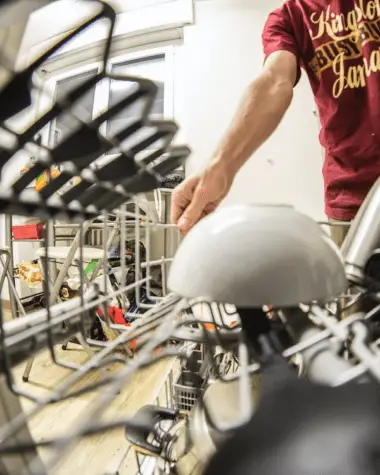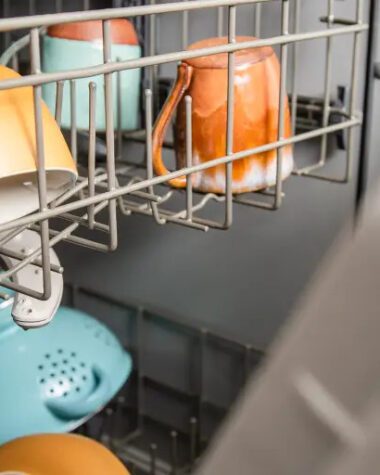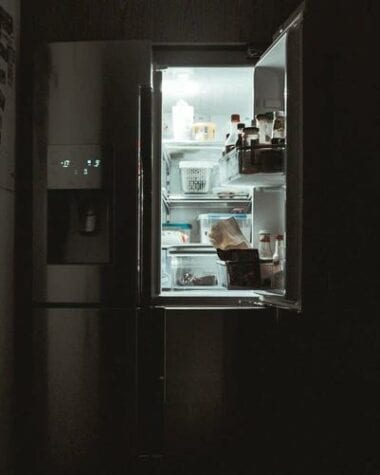Suppose you’re thinking about buying a brand-new 30-inch refrigerator or are just interested in your existing one. In that case, you need to understand how much amperage it uses because it is one of the primary reasons that greatly impact your electricity expenses.
Unfortunately, such information isn’t going to be available in your local retail store pamphlets or on the back of the refrigerator itself.
That being said, how can you determine the total amperage your refrigerator consumes?
For starters, you can connect an energy meter to the circuit, but a refrigerator keeps its electricity consumption low as it sits in a showroom, waiting for you to purchase it.
The kitchen has experienced more technological developments than any before in recent years. It’s a homeowner’s dream, with everything from extravagant air fryers to handy dishwashers to keep your hands clean while you clean those filthy plates and glassware after a delicious meal.
But how certain are you that your appliances are secure for daily use before purchasing them if you need to become acquainted with the energy consumption measurement? Is the energy expense you’re paying for them reasonable?
In order to have a better understanding of how appliances utilize energy and substantially decrease your monthly utility bills, we here at DaDongNy will explain understandably exactly the amount of amps a refrigerator consumes over the course of this blog post.
The Concept Of Amps
Amps are measurement units for the rate electric currents flow through a substance. When estimating how much electricity a piece of equipment or an appliance uses, amps, watts, and volts are important factors.
Meanwhile, watts are the measurement units used to determine how much energy an appliance or equipment consumes. Amps are multiplied with voltage (A x V = W) to determine the refrigerator’s wattage. On the other hand, wattage is multiplied by voltage (W / V = A) to determine the total amps of your refrigerator.
Being aware of what an amp is is extremely important in determining how much electrical consumption equipment like the refrigerator uses as it differs depending on its brand and style while voltage stays fixed. According to Energy Sage, refrigerators have an average wattage ranging between 300 to 800, which at 120 volts, computes to an amperage of 2.5 to 6.66 amps.
And refrigerators, as we all know, are plugged into a standard wall outlet. Their voltage, therefore, is always 120, especially here in North America.
Finding the refrigerator’s energy usage is simple once we’ve determined the equipment’s voltage and amperage.
A residential home’s maximum amp capacity per circuit breaker is 15 or 20 amps. If you use more, the electrical circuit breaker will go off, shutting down the power. Because it takes more power to operate a refrigerator than it requires to run it, all refrigerators units must have a starting amperage of 15 or 20 amps.
Simple Methods For Calculating The Amps Of Your Refrigerator
As previously stated, you can determine the number of amps your refrigerator draws in by determining the appliance’s wattage and dividing this number by the voltage of the circuit it is plugged into.
For example, if your refrigerator has a wattage of 500 and is hooked into a 120-volt circuit, you would divide 500 by 120 to get 4.17 amps.
Furthermore, there are numerous methods for determining the amp capacity of your refrigerator:
- Take A Look At The Energy Star Rating Label
Your refrigerator’s energy star rating can give you a decent idea of the number of amps it will consume regularly. This sticker, typically seen inside your refrigerator’s door or close to the control panel, describes the approximate electricity consumption of the respective equipment. In general, the greater the number, the more effective your equipment is.
- Check The Manufacturer’s Specs
The company that produces the model of your refrigerator ought to include the specific wattage, amps, and voltage requirements in their product description. You can get this information on their website or the refrigerator’s owner’s handbook. It will be easier to ensure that your refrigerator is drawing the appropriate amount of electricity for the circuit it is plugged into if you know how much energy your appliance needs.
- Calculate With The Help Of The Nameplate
Your refrigerator’s nameplate will include two key pieces of information: how many volts it requires to run and how much energy it consumes. By multiplying these two values, you may know how many amps your refrigerator consumes.
For example, if the voltage is 120 volts and the wattage of your brand-new refrigerator is 500 watts, then 120 (V) x 500 (W) = 60,000 watts, or 60 amps can be calculated.
How Many Amps Are Required By Refrigerators?
There is no such thing as a typical refrigerator. Refrigerators are accessible in a variety of styles and sizes. So instead of looking at the number of amps used by an average refrigerator, we will look at the power consumption of different refrigerators.
The energy efficiency of a refrigerator is significantly determined by its size and year of manufacture. That being said, let’s look at a couple of examples to see how different kinds of refrigerators consume varied degrees of electricity.
- Top-Freezer Refrigerators
Top freezer refrigerators have two compartments: the refrigerator in the lower chamber and the freezer in the upper compartment. These are the most popular types of refrigerators seen in every household.
They typically come with a whopping 16 cubic feet of storage space, including freezer and refrigerator capacity. Although these dimensions may differ slightly, they are typically approximately 62 inches tall, 30 inches broad, and 32 inches deep.
Top freezer refrigerators typically consume around 250 to 600 watts per hour, while some can consume more. That being said, the average amps of a top-freezer refrigerator range between 2 and 5.
- Bottom-Freezer Refrigerators
Bottom freezers have nearly identical specs to top-freezer refrigerators. They are roughly the same size and volume, except the freezer is on the bottom.
They are usually 62 inches high, 32 inches wide, and 32 inches deep. These dimensions may differ from one appliance to one another. Larger refrigerators consume more electricity, requiring more amps.
Like top freezers, bottom-freezer refrigerators typically use 250 to 600 watts per hour, garnering a total amperage usage of between 2 and 5 amps.
- Side-By-Side Refrigerators
Side-by-side refrigerators, the most common form of refrigerators seen in residential properties, have two doors: one for the freezer and one for the fridge. Their refrigerators provide a unique space design that some customers prefer.
They are usually 67 to 70 inches tall, 32 to 38 inches wide, and 30 to 36 inches in depth. They use about as much electricity as a refrigerator with French doors.
Side-by-side refrigerators require between 300 and 700 watts per hour, with some consuming even more, depending on their size. A refrigerator that draws on 300 watts requires at least 2.5 amps to run. If it consumes 700 watts, it requires at least 5.8 amps.
- French Door Refrigerators
French door refrigerators have two doors on top and one or two freezer drawers underneath. They have a distinct design, and the two opening doors make it easier for owners to access the fridge’s difficult-to-reach places. Furthermore, these refrigerators are getting increasingly popular in today’s market.
French door refrigerators are usually between 67 and 70 inches tall, 30 to 36 inches wide, and 29-35 inches in depth. They are frequently larger than the bottom- or top-freezer refrigerators and, as a result, consume more power. French door refrigerators frequently have three doors, which might result in ineffectiveness because there are more places for cool air to escape.
French door refrigerators utilize between 300 and 700 watts an hour on average. That is, they typically consume between 2 and 6 amps during operation.
- RV Refrigerators
RV refrigerators are not a typical type of refrigerator, but as RVs have grown in popularity, so have refrigerators that fit within. RV refrigerators are often larger than mini-fridges, ranging from 4 to 12 cubic feet. Aside from size, RV refrigerators are comparable to mini-fridges.
Although some people utilize mini-fridges in their RVs, their size may prevent them from being used to their full potential. RV refrigerators usually have two doors, similar to a standard refrigerator. On the other hand, mini-fridges only have a single compartment. These refrigerators are ideal for folks who require additional space but are unable to accommodate a standard-sized refrigerator.
RV refrigerators must maintain a cool temperature while utilizing minimal electricity. In order to do that, RV refrigerators usually draw approximately 200 and 500 watts of energy per hour. They, therefore, require between 1.5 and 4 amps for proper operation.
- Mini Fridges
Because of their small size, mini-fridges consume relatively less energy. That being said, they require less amperage because of their minimal power consumption.
Mini-fridges are often defined as refrigerators with less than 4.5 cubic feet of interior space. Comparatively, the volume of a typical, standard-sized refrigerator is about 18 cubic feet.
These refrigerators usually draw about 55 to 85 watts per hour. However, in certain situations, they can produce up to 240 watts. To calculate refrigerator amps, divide the watts by the voltage, which we know is 120 on average. Since they may use less power, mini-fridges often use a maximum of 2 amps.
- Older Models
Older refrigerator models consume an extensive amount of electricity. With that, the United States government decided to establish the initiative known as Energy Star in 1995, to lower electricity costs for consumers and the overall energy consumption of home appliances.
Since older refrigerators were manufactured before implementing Electricity Star regulations, they consume significantly more electricity than the present variations. On the other hand, some older refrigerator models can consume twice as much energy as a new refrigerator.
These refrigerators can consume up to 1500 watts, approximately double the energy consumption of the most energy-efficient modern refrigerator. If a refrigerator consumes 1500 watts, it only requires at least 13 amps and consumes nearly three times as much power as a newer refrigerator.
Factors That Determine The Amps Consumption Of A Refrigerator
The total quantity of electricity consumed by a refrigerator is determined by various factors, including the wattage it requires, the extent to how insulated it is, how frequently the door gets opened, and how cool you set the temperature. Your refrigerator’s amp usage will increase as its required power increases.
It will also require more electricity to keep your food cold if your refrigerator is properly insulated. Opening the door regularly increases your appliance’s electricity since it has to work harder to preserve the appropriate temperature.
The last thing to consider is that if you maintain the interior temperature colder than usual, your refrigerator will be consuming more energy.
Amperage Consumption Chart
Aside from the refrigerator, the following chart will show you how many amps the most popular appliances consume:
| Appliances | Amperage Consumption |
|---|---|
| Toaster | 8-10 amps |
| Coffee Maker | 5-8 amps |
| Television | 15-4 amps |
| Refrigerator | 5-8 amps |
| Space Heater | 7-13 amps |
| Water Heater | 8-13 amps |
| Game Console | 0.5-0.8 amps |
| Vacuum | 2-6 amps |
| Hair Dryer | 7-13 amps |
| Frying Pan | 7-12 amps |
| Furnace Fan | 7-9 amps |
| Microwave Oven | 7-13 amps |
| Washer or Dryer | 14-16 amps |
FAQs
- Do Refrigerators Consume A Lot Of Energy?
Unfortunately, refrigerators can significantly increase the cost of your electricity bill despite providing an important role in keeping your foods fresh and your beverages ice cold just like you wanted.
Refrigerators are most commonly known as the second-largest energy-consuming appliance in every household due to heating and cooling.
- Is It Necessary For Refrigerators To Have Their Circuit?
Most of the time, homeowners need to pay more attention to the necessity of installing a separate circuit breaker for their refrigerators. Keep in mind that your refrigerator requires 3-6 amps to run smoothly, but it can rise to 15 amps during its optimum consumption.
Always consider worst-case scenarios, especially when adjusting the power supply of your refrigerator, to avoid energy surges and other issues down the road.
- Is Running a Refrigerator On A 15-20 Amp Circuit Possible?
To put it simply, yes. Refrigerators and freezers should have their own 15 amp, 120-volt circuit to keep your kitchen working smoothly and safely. Doing this can eliminate the risk of electrical surges brought on by old electrical wiring.
A 20 amp circuit, on the other hand, is also good for use and can easily handle up to two normal freezers in the same line. As long as no additional appliances are hooked up to the same line, you can use all your available electricity without worrying about overwhelming your circuit breaker.
- Is It Possible To Connect A Refrigerator To A Surge Protector?
Connecting your refrigerator to a surge protector is something that we highly discourage. In the case of a power surge, their compressors, which are temperature and current-overload-sensitive, could immediately shut down, rendering them useless until you reset your LG refrigerator.
- When To Consult For Professional Help?
If you need help with how to supply electricity to your refrigerator? Hire a qualified electrician straight away to assist you. They have the appropriate knowledge and skills required to determine exactly what amps, watts, or volts your refrigerator could need.
Furthermore, they can offer safe wiring techniques that work for you, thus keeping things on track.
Bottomline
To answer the million dollar question of “How much amp does your refrigerator consume?”, it will vary depending on the sort of refrigerator you own. Smaller refrigerators consume less energy; thus, they require fewer amps, but larger refrigerators demand more amps.
We hope this blog post will help you comprehend how much electrical energy your refrigerator is eating and, ideally, keep your refrigerator and all of your appliances running as efficiently as possible.
To learn more about refrigerators and how this valuable piece of equipment chills the food and beverages inside, check out the post here.
Articles You May Be Interested In
- A Cooler Choice: Whirlpool v.s GE Refrigerators (Full Guide)
- Refrigerator Check: LG v.s Samsung Refrigerators (Full Guide)
- Cool Tech Showdown: Frigidaire v.s Whirlpool Refrigerators (Full Guide)
- Fridge Favorites: Bosch v.s LG Refrigerators (Full Guide)
- Cooling Conundrum: Whirlpool v.s Samsung Refrigerators (Full Guide)
- Tale Of The Tape: Maytag v.s Whirlpool Refrigerators (Full Guide)
- Fridges in Focus: Thermador v.s Sub-Zero Refrigerators (Full Guide)
- Fridge Frenzy: Sub-Zero v.s Viking Refrigerators (Full Guide)
- The Big Chill: Whirlpool v.s KitchenAid Refrigerators (Full Guide)
- Refrigerator Bout: Whirlpool v.s LG Refrigerators (Full Guide)









